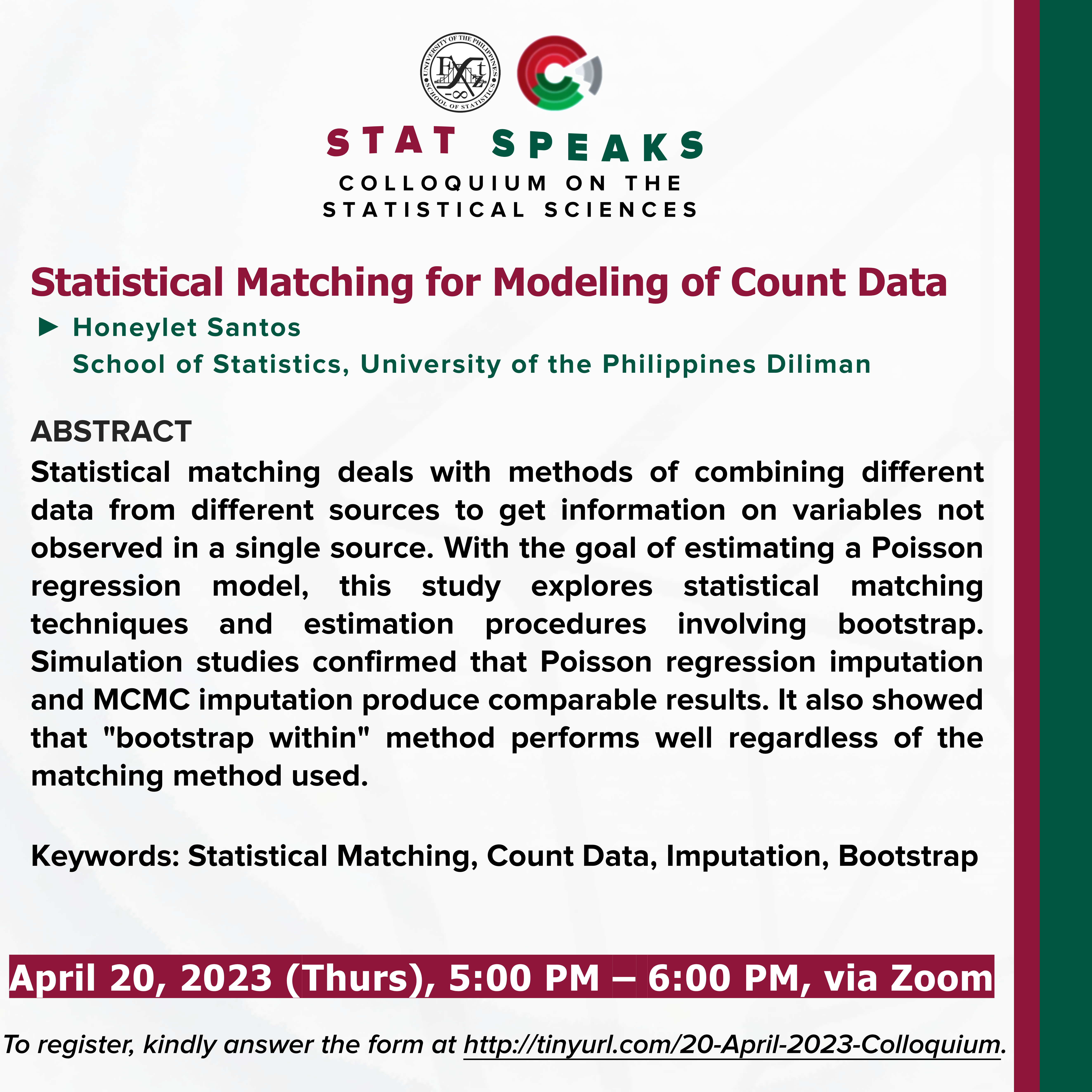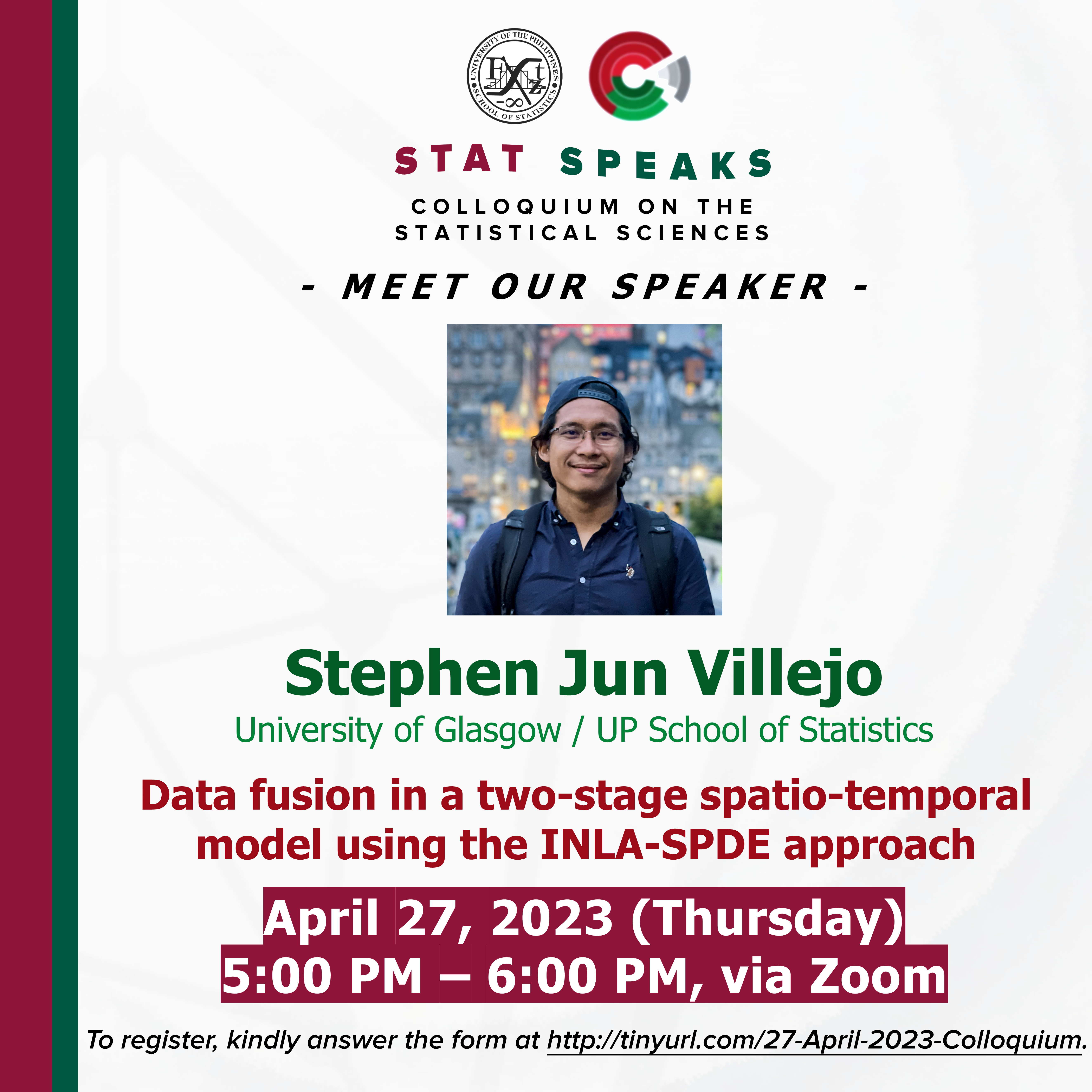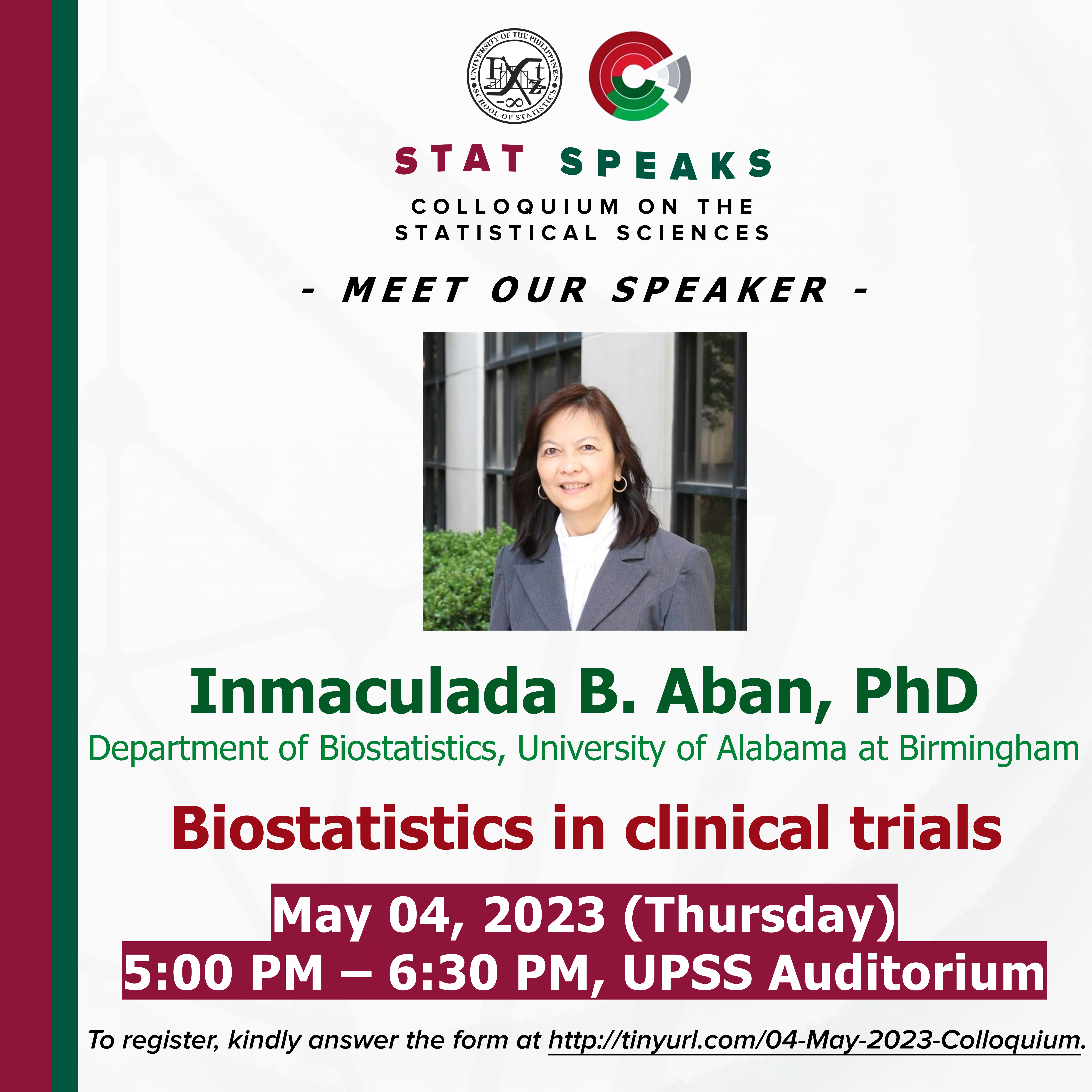Colloquium, Trainings, and Events
-

STAT SPEAKS: Colloquium on the Statistical Sciences
Last updated: April 5, 2024, 4:15 p.m.
Speaker: Assoc. Prof. Francisco De Los Reyes
Date: April 11, 2024, 5 p.m.
Venue: UPSS Lecture Hall I
Abstract: With the third iteration of the no-test UP college admission, there is a need to study, assess, and address if the excellence with economic and geographic equity creed worked. This research looks into the collective characteristics of applicants from Metro Manila and all provinces as they are geospatially distributed, accounting for variation in the information asked in the UPCA application process. Specifically, the research describes the spatial distribution of applicant characteristics at the provincial level; determines if spatial autocorrelation is present among the number of qualifiers and qualifying rates of provinces; and formulates a model that significantly explains variability in the number of qualifiers given spatial autocorrelation and other explanatory variables.
[STAT SPEAKS]
UPSS and UPSCRFI invite you to attend the colloquium on 11 April 2024 from 5:00 PM - 6:30 PM in UPSS Lecture Hall 1!
Exploring the Application and Qualification Patterns in the University of the Philippines College Admission 2023 using a Geospatial Framework
𝐅𝐫𝐚𝐧𝐜𝐢𝐬𝐜𝐨 𝐍. 𝐃𝐞 𝐋𝐨𝐬 𝐑𝐞𝐲𝐞𝐬
Associate Professor, School of Statistics, UP Diliman
Director, Office of Admissions, University of the Philippines
Kindly answer the form at https://bit.ly/Colloquium-2024-04-11 to register. -
STAT SPEAKS
Last updated: Jan. 5, 2023, 4:20 p.m.
Speaker: 𝙍𝙚𝙜𝙞𝙣𝙖 𝙈. 𝙏𝙧𝙚𝙨𝙫𝙖𝙡𝙡𝙚𝙨
Date: Jan. 12, 2023, 4 p.m.
Venue: via Zoom
Abstract: This paper proposes to use a spatio-temporal model with structural change for the spread of the coronavirus disease 2019 (COVID-19), showing its suitability in the pandemic experience in the Philippines, from the first recorded case in the country to the end of the fourth surge in October 2021. This model was originally proposed by Bastero and Barrios in 2011. The result uses a spatiotemporal model that incorporates the forward search algorithm and maximum likelihood estimation into the backfitting framework. The forward search algorithm is used to filter the effect of short-term structural change in the estimation of covariate and spatial parameters. The method that uses the effect of structural change offers good model fit especially in COVID-19 experience in the Philippines where structural change is encountered at different space and time. It is further explored in this paper how this spatiotemporal model may be incorporated in the compartmental mathematical models for COVID-19.
Keywords: spatio-temporal model, structural change, forward search, COVID-19You are invited to attend the colloquium to be held on January 12, 2023 (Thursday) via Zoom as part of the Stat 396 (Seminar) requirement.
𝐒𝐩𝐚𝐭𝐢𝐨𝐭𝐞𝐦𝐩𝐨𝐫𝐚𝐥 𝐌𝐨𝐝𝐞𝐥𝐢𝐧𝐠 𝐨𝐟 𝐂𝐎𝐕𝐈𝐃-𝟏𝟗 𝐢𝐧 𝐭𝐡𝐞 𝐏𝐡𝐢𝐥𝐢𝐩𝐩𝐢𝐧𝐞𝐬 𝐢𝐧 𝐭𝐡𝐞 𝐏𝐫𝐞𝐬𝐞𝐧𝐜𝐞 𝐨𝐟 𝐒𝐭𝐫𝐮𝐜𝐭𝐮𝐫𝐚𝐥 𝐂𝐡𝐚𝐧𝐠𝐞
𝙍𝙚𝙜𝙞𝙣𝙖 𝙈. 𝙏𝙧𝙚𝙨𝙫𝙖𝙡𝙡𝙚𝙨
Asst. Professor, Department of Mathematics and Statistics, De La Salle University & Doctor of Philosophy Candidate, UP School of Statistics
4:00-5:00 PM
Kindly answer the form at tinyurl.com/StatSpeaks011223 to register. -

STAT SPEAKS
Last updated: April 18, 2023, 5:06 p.m.
Speaker: Honeylet Santos
Date: April 20, 2023, 5 p.m.
Venue: via Zoom
Abstract: Statistical matching deals with methods of combining different data from different sources to get information on variables not observed in a single source. With the goal of estimating a Poisson regression model, this study explores statistical matching techniques and estimation procedures involving bootstrap. Simulation studies confirmed that Poisson regression imputation and MCMC imputation produce comparable results. It also showed that "bootstrap within" method performs well regardless of the matching method used.
Keywords:
statistical matching, count data, imputation, bootstrapYou are invited to attend the colloquium to be held on April 20, 2023 (Thursday) via Zoom.
Statistical Matching for Modeling of Count Data
Honeylet Santos
Asst. Professor, UP School of Statistics
5:00-6:00 PM
Kindly answer the form at tinyurl.com/20-April-2023-Colloquium to register. -

STAT SPEAKS
Last updated: April 18, 2023, 5:06 p.m.
Speaker: Stephen Jun Villejo
Date: April 27, 2023, 5 p.m.
Venue: via Zoom
Abstract: We propose a two-stage latent Gaussian model for a specific spatial misalignment problem. We use the integrated nested Laplace approximation (INLA) to perform inference. The first-stage model is based on the Bayesian melding which does data fusion by assuming a common latent field for the observed outcomes. We use the stochastic partial differential equations (SPDE) approach to efficiently estimate the spatial field. It induces a Markov structure on the field which leads to sparse precision matrices giving great computational gains. Uncertainty in the first stage is accounted for by simulating repeatedly from the posterior predictive distribution of the field. A simulation study was carried out to assess the impact of the sparsity of the data, the number of time points, and the specification of the priors in terms of the biases, RMSEs, and coverage probabilities. The results show that the parameters are generally estimated correctly, but there is difficulty in estimating the random field parameters. The method is applied to NO2 concentration and respiratory hospitalizations for the year 2017 in England. An increase in NO2 levels is significantly associated with an increase in the relative risks of the health outcome. Also, there is a strong spatial structure and a strong temporal autocorrelation in the risks.
You are invited to attend the colloquium to be held on April 27, 2023 (Thursday) via Zoom!
Data fusion in a two-stage spatio-temporal model using the INLA-SPDE approach
Stephen Jun V. Villejo
Asst. Professor, UP School of Statistics
5:00-6:00 PM
Kindly answer the form at tinyurl.com/27-April-2023-Colloquium to register. -

STAT SPEAKS: Colloquium on the Statistical Sciences
Last updated: Oct. 19, 2023, 9:27 a.m.
Speaker: Hernando Ombao, Ph.D.; Anass El Yaagoubi Bourakna; Paolo Victor Redondo
Date: July 21, 2023, 3 p.m.
Venue: UPSS Lecture Hall I
You are invited to attend the colloquium to be held on July 21, 2023, at the UP School of Statistics Lecture Hall I from 3:00 PM - 5:00 PM!
𝐎𝐯𝐞𝐫𝐯𝐢𝐞𝐰 𝐨𝐟 𝐒𝐩𝐞𝐜𝐭𝐫𝐚𝐥 𝐀𝐧𝐚𝐥𝐲𝐬𝐢𝐬 𝐨𝐟 𝐌𝐮𝐥𝐭𝐢𝐯𝐚𝐫𝐢𝐚𝐭𝐞 𝐓𝐢𝐦𝐞 𝐒𝐞𝐫𝐢𝐞𝐬
Hernando Ombao, Ph.D.
Professor and Chair, Statistics Program
𝐒𝐩𝐞𝐜𝐭𝐫𝐚𝐥 𝐓𝐨𝐩𝐨𝐥𝐨𝐠𝐢𝐜𝐚𝐥 𝐃𝐚𝐭𝐚 𝐀𝐧𝐚𝐥𝐲𝐬𝐢𝐬 𝐟𝐨𝐫 𝐁𝐫𝐚𝐢𝐧 𝐒𝐢𝐠𝐧𝐚𝐥𝐬
Anass El Yaagoubi Bourakna
Ph.D. student, Statistics Program
𝐌𝐞𝐚𝐬𝐮𝐫𝐢𝐧𝐠 𝐈𝐧𝐟𝐨𝐫𝐦𝐚𝐭𝐢𝐨𝐧 𝐓𝐫𝐚𝐧𝐬𝐟𝐞𝐫 𝐁𝐞𝐭𝐰𝐞𝐞𝐧 𝐍𝐨𝐝𝐞𝐬 𝐢𝐧 𝐚 𝐁𝐫𝐚𝐢𝐧 𝐍𝐞𝐭𝐰𝐨𝐫𝐤
Paolo Victor Redondo
Ph.D. student, Statistics Program
The speakers are from the King Abdullah University of Science and Technology (KAUST).
Kindly answer the form at bit.ly/2023-July-21-Colloquium to register.Files :
Abstract (Hernando Ombao, Ph.D.)
Abstract (Anass El Yaagoubi Bourakna)
Abstract (Paolo Victor Redondo )
-

STAT SPEAKS
Last updated: Aug. 3, 2023, 2:10 p.m.
Speaker: 𝙃𝙚𝙣𝙧𝙮 𝙅𝙤𝙨𝙚𝙥𝙝 𝙈. 𝙃𝙚𝙧𝙧𝙚𝙧𝙖, 𝙁𝘼𝙎𝙋
Date: Aug. 10, 2023, 4 p.m.
Venue: UPSS Lecture Hall I
Abstract: The talk discusses a roadmap to achieving financial freedom - its stages and the Philippine experience. Sources and expected amounts of retirement funds from mandated social insurance and private employers will be covered. Building an individual retirement account as early as possible will be highlighted to supplement these retirement benefits provided by law. A worksheet will be provided to participants to enable them to determine the amount they need to retire comfortably at the age they desire to retire.
You are invited to attend the colloquium to be held on August 10, 2023 (Thursday) at the UPSS Lecture Hall I.
𝐓𝐡𝐞 𝐑𝐨𝐚𝐝𝐦𝐚𝐩 𝐭𝐨 𝐚 𝐅𝐢𝐧𝐚𝐧𝐜𝐢𝐚𝐥𝐥𝐲 𝐒𝐞𝐜𝐮𝐫𝐞 𝐅𝐮𝐭𝐮𝐫𝐞
𝙃𝙚𝙣𝙧𝙮 𝙅𝙤𝙨𝙚𝙥𝙝 𝙈. 𝙃𝙚𝙧𝙧𝙚𝙧𝙖, 𝙁𝘼𝙎𝙋
Fellow, Actuarial Society of the Philippines
4:00-5:00 PM
Kindly answer the form at bit.ly/2023-August-10-Colloquium to register. -

STAT SPEAKS: Colloquium on the Statistical Sciences
Last updated: Oct. 19, 2023, 9:20 a.m.
Speaker: 𝙈𝙧. 𝙂𝙚𝙧𝙖𝙧𝙙 𝙎𝙖𝙣𝙩𝙤𝙨
Date: Sept. 28, 2023, 5 p.m.
Venue: UPSS Lecture Hall I
Abstract: The celebration is made possible by our partners:
IN PARTNERSHIP WITH
Accenture Inc.
Cocolife
UPSS Alumni Association
UPSS Class '93
UPSS Class '97
UPSS Class '99
ALSO BROUGHT TO YOU BY
Unilab
Pfizer
UPSS Class 2009
SPECIAL THANKS TO
TeaVia MR, Inc.
EGM Lending Corp.You are invited to attend the colloquium to be held on September 28, 2023 (Thursday) at the UPSS Lecture Hall I from 5:00 - 6:00 PM.
𝐄𝐬𝐭𝐚𝐛𝐥𝐢𝐬𝐡𝐢𝐧𝐠 𝐚 𝐒𝐨𝐥𝐢𝐝 𝐃𝐚𝐭𝐚 𝐅𝐨𝐮𝐧𝐝𝐚𝐭𝐢𝐨𝐧: 𝐃𝐚𝐭𝐚 𝐌𝐚𝐧𝐚𝐠𝐞𝐦𝐞𝐧𝐭 𝐚𝐧𝐝 𝐐𝐮𝐚𝐥𝐢𝐭𝐲 𝐄𝐬𝐬𝐞𝐧𝐭𝐢𝐚𝐥𝐬
𝙈𝙧. 𝙂𝙚𝙧𝙖𝙧𝙙 𝙎𝙖𝙣𝙩𝙤𝙨
Data Engineering Associate Manager, Accenture Philippines
Kindly answer the form at bit.ly/2023-August-10-Colloquium to register. -

STAT SPEAKS: Colloquium on the Statistical Sciences
Last updated: Oct. 19, 2023, 9:34 a.m.
Speaker: 𝙄𝙣𝙢𝙖𝙘𝙪𝙡𝙖𝙙𝙖 𝘽. 𝘼𝙗𝙖𝙣, 𝙋𝙝𝘿
Date: May 4, 2023, 5 p.m.
Venue: UPSS Auditorium
Abstract: We will discuss the basic elements of clinical trials and the role of biostatistics in these trials. Two specific trials will serve as illustrations. First trial is the completed MGTX Trial, a randomized blinded controlled study of a surgical treatment for myasthenia gravis. The second trial is the ongoing TeleCOPD, a randomized controlled trial that tests whether a video telehealth pulmonary rehabilitation intervention for COPD patients will reduce hospital readmissions, improve quality of life, and be cost-effective. I will summarize the skills and knowledge to be a successful biostatistician in clinical trial research. I will end the talk with a brief discussion of the Biostatistics graduate programs and certificates offered at UAB.
You are invited to attend the colloquium to be held on May 4, 2023, at the UP School of Statistics auditorium from 5:00-6:30 PM!
𝐁𝐢𝐨𝐬𝐭𝐚𝐭𝐢𝐬𝐭𝐢𝐜𝐬 𝐢𝐧 𝐂𝐥𝐢𝐧𝐢𝐜𝐚𝐥 𝐓𝐫𝐢𝐚𝐥𝐬
𝙄𝙣𝙢𝙖𝙘𝙪𝙡𝙖𝙙𝙖 𝘽. 𝘼𝙗𝙖𝙣, 𝙋𝙝𝘿
Professor of Biostatistics, University of Alabama at Birmingham
Kindly answer the form at tinyurl.com/04-May-2023-Colloquium to register -

NOVEMBER 2023 TRAINING SEMINARS
Last updated: Oct. 19, 2023, 9:37 a.m.
Date: Nov. 8, 2023, 9 a.m.UP School of Statistics, in collaboration with the University of the Philippines Statistical Center Research Foundation, Inc. (UPSCRFI), is pleased to announce the School's onsite training seminars in applied statistics this November 2023.
𝐁𝐚𝐬𝐢𝐜 𝐒𝐭𝐚𝐭𝐢𝐬𝐭𝐢𝐜𝐬 𝐰𝐢𝐭𝐡 𝐄𝐱𝐩𝐥𝐨𝐫𝐚𝐭𝐨𝐫𝐲 𝐃𝐚𝐭𝐚 𝐀𝐧𝐚𝐥𝐲𝐬𝐢𝐬
8-10 November 2023
9:00 AM to 12:00 NN; 1:00 PM to 4:00 PM
𝐈𝐧𝐭𝐫𝐨𝐝𝐮𝐜𝐭𝐢𝐨𝐧 𝐭𝐨 𝐑 𝐚𝐧𝐝 𝐃𝐚𝐭𝐚 𝐌𝐚𝐧𝐚𝐠𝐞𝐦𝐞𝐧𝐭 𝐔𝐬𝐢𝐧𝐠 𝐭𝐡𝐞 𝐓𝐢𝐝𝐲𝐯𝐞𝐫𝐬𝐞 𝐄𝐜𝐨𝐬𝐲𝐬𝐭𝐞𝐦
15-17 November 2023
9:00 AM to 12:00 NN; 1:00 PM to 4:00 PM
𝐀𝐩𝐩𝐥𝐢𝐞𝐝 𝐒𝐭𝐚𝐭𝐢𝐬𝐭𝐢𝐜𝐚𝐥 𝐅𝐨𝐫𝐞𝐜𝐚𝐬𝐭𝐢𝐧𝐠
23-24 November 2023
9:00 AM to 12:00 NN; 1:00 PM to 4:00 PM
The training seminar fee for each module per participant is Php 10,000. Discounted rates are available for individuals who will register for more than one module and for groups of at least 10 participants.
Register here: https://bit.ly/UPSS-November2023-Trainings
See more details: https://bit.ly/UPSS-November2023-Trainings-Info
We look forward to seeing you in one of our training seminars! -

STAT SPEAKS: Colloquium on the Statistical Sciences
Last updated: Oct. 19, 2023, 6:50 p.m.
Date: Oct. 26, 2023, 5 p.m.Venue: via Zoom
UPSS and UPSCRFI invite you to attend the colloquium on 26 October 2023 from 5:00 PM - 6:00 PM via Zoom!
𝐇𝐢𝐠𝐡𝐥𝐢𝐠𝐡𝐭𝐬 𝐨𝐟 𝐀𝐃𝐁’𝐬 𝐊𝐞𝐲 𝐈𝐧𝐝𝐢𝐜𝐚𝐭𝐨𝐫𝐬 𝟐𝟎𝟐𝟑
Arturo Martinez. Jr., Statistician
Anna Marie Fernando, Economics and Statistics Specialist
Peter Julius Villarta, IT Consultant
Kindly answer the form at https://bit.ly/2023-October-26-Colloquium to register.
The celebration is made possible by our partners:
IN PARTNERSHIP WITH
Accenture Inc.
Cocolife
UPSS Alumni Association
UPSS Class '93
UPSS Class '97
UPSS Class '99
ALSO BROUGHT TO YOU BY
Unilab
Pfizer
UPSS Class 2009
SPECIAL THANKS TO
TeaVia MR, Inc.
EGM Lending Corp.
#Stat70theFuture
#TrailblazingTodayTransformingTomorrow
Highlights
UP STAT Faculty calls out abuse in survey methodologies
OFFICIAL STATEMENT OF THE FACULTY OF UP SCHOOL OF STATISTICS on the Proliferation of Surveys with Unclear Methodologies We, the faculty members ...
View our Most Read Article
Employment Correlates of Multidimensional Poverty in the Philippines
One of the highlights of the 2015 UP School of Statistics Recognition Rites was the announcement of the recipients of the Best Undergraduate Student Paper Award.
View our most read journal
STAT SPEAKS: Colloquium on the Statistical Sciences
STAT SPEAKS: Colloquium on the Statistical Sciences
Date: April 11, 2024 5 PM
Speaker: Assoc. Prof. Francisco De Los Reyes
View our Recent Event